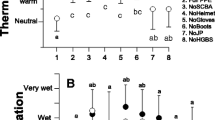Abstract
The aim of the present study was to examine the effectiveness of ice-packs (ICE) and phase change material (PCM) cooling devices in reducing physiological load based on subjects’ physiological and subjective responses while the subjects exercised on a bicycle ergometer while wearing firefighting protective clothing in a relatively high temperature environment (30°C, 50%RH). Subjects were eight graduate students, aged 25.9 years (SD 3.2). Each subject participated in four 50-min exposures: control (CON), ICE, PCM of 5°C [PCM(5)] and 20°C [PCM(20)]. Each subject rested in a pre-test room for 10 min before entering the test-room where they rested for another 10 min, followed by 30 min-exercise and a 10 min-recovery period. The exercise intensity was set at 55%VO2max. Cooling effects were evaluated by measuring rectal temperature (Tre), mean skin temperature (Tsk), body weight loss and subjective responses. An increase in Tre for PCM(5) and PCM(20) which was less than that for CON and ICE was observed. The increases in Tsk were depressed using cooling devices, but the cooling effects of PCMs were greater than ICE. The subjects with CON felt hotter and wetter than those in the other conditions. The larger surface cooling area, higher melting temperature and softer material of PCMs which reduces absorption capacity caused a decrease in Tre and Tsk for PCM(5) and PCM(20) which was more than that for CON and ICE. Furthermore, PCM(20) does not require refrigeration. These results suggest that PCM(20) is more effective than other cooling devices in reducing the physiological load while wearing firefighting protective clothing.






Similar content being viewed by others
References
Bennett BL, Hagan RD, Huey KA, Minson C, Cain D (1995) Comparison of two cool vests on heat-strain reduction while wearing a firefighting ensemble. Eur J Appl Physiol Occup Physiol 70:322–328
Bishop P, Smith G, Ray P, Beaird J, Smith J (1994) Empirical prediction of physiological response to prolonged work in encapsulating protective clothing. Ergonomics 37:1503–1512
Burton AC (1935) Human calorimetry. II. The average temperature of the tissues of the body. J Nutr 9:261–280
Duncan HW, Gardner GW, Barnard RJ (1979) Physiological responses of men working in fire fighting equipment in the heat. Ergonomics 22:521–527
Faff J, Tutak T (1989) Physiological responses to working with fire fighting equipment in the heat in relation to subjective fatigue. Ergonomics 32:629–638
Fitchett MA (1985) Predictability of VO2max form submaximal cycle ergometer and bench stepping test. Br J Sports Med 19:85–88
Hardy JD, Dubois EF (1938) The technique of measuring radiation and convection. J Nutr 15:461–475
McLellan TM and Frim J (1998) Efficacy of liquid, air, and phase change material torso cooling during light exercise while wearing NBC clothing. Defense and Civil Institute of Environmental Medicine, Toronto, Canada. DCIEM No. 98-R-36
Muir IH, Bishop PA, Ray P (1999) Effects of a novel ice-cooling technique on work in protective clothing at 28°C, 23°C, and 18°C WBGTs. Am Ind Hyg Assoc J 60:96–104
Nakahashi M, Murayama M, Monobe H, Ikuno H (2003) Relationship between wearing time period and moving quantity of fireman’s turnout based on a scenario of fire. Jpn J Physiol Anthropol 8:83–89
Pause B (2003) Nonwoven protective garments with thermo-regulating properties. J Ind Text 33:93–99
Tochihara Y, Chou C, Fujita M, Ogawa T (2005) Protective clothing-related heat stress on firefighters in Japan. In: Holmer I, Kulane K, Gao C (eds) Environmental ergonomics XI. Y stad, Sweden, pp 137–139
Webster J, Holland EJ, Sleivert G, Laing RM, Niven BE (2005) A light-weight cooling vest enhances performance of athletes in the heat. Ergonomics 48:821–837
Acknowledgments
The authors appreciate the special advice given by Dr. Takako Fukazawa. We would like to acknowledge and express our gratitude to the Japan Fire Retardant Association (JFRA) and a Grant-in-Aid for Scientific Research (No.16107006) from the Japan Society for the Promotion of Science(JSPS).
Author information
Authors and Affiliations
Corresponding author
Rights and permissions
About this article
Cite this article
Chou, C., Tochihara, Y. & Kim, T. Physiological and subjective responses to cooling devices on firefighting protective clothing. Eur J Appl Physiol 104, 369–374 (2008). https://doi.org/10.1007/s00421-007-0665-7
Accepted:
Published:
Issue Date:
DOI: https://doi.org/10.1007/s00421-007-0665-7



